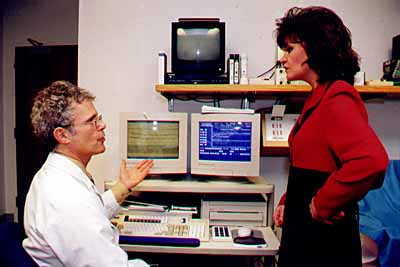How do you know if you're sleeping normally? How do you know if you're getting enough good quality sleep? Normal sleep in any individual consists of a range of sleeping time. Some require as few as 4-5 hours of adequate sleep each 24 hours to be alert the next day, as Winston Churchill is said to have needed (but also supplemented with occasional daytime catnaps!). Other normal people can't get by without 9-10 hours a night. The normal average that suits 80% of people is in the 7-8 hour range. In our culture, that 7-8 hours is usually spent in one concentrated period; in other countries, the nighttime component may be shorter with a long midday snooze.

Figure explaining "normal sleep"
The normal pattern of sleep, as read off a person's EEG (brainwave) test, is shown. A person will have a series of cycles consisting of REM and NonREM sleep. Stages 1-4 of NonREM sleep are progressively deeper. In Stage 1, a brief transitional sleep, a person can arouse easily by just being spoken to. The total time of all the Stage 2 sleep is typically 30-50% of the night. Stages 3 and 4 are very deep sleep that occurs most in the earlier night cycles. REM sleep, indicated by the thicker line, is often associated with dreaming. It occurs roughly every 90 minutes, usually 3-5 times per night.
Normally, an individual has fairly predictable stages of sleep. There are ways to determine what stage a person is in by using a brainwave test. The two types of stages are called REM (rapid eye movement) sleep and NonREM sleep. A person will generally go through 3-6 cycles of REM and NonREM sleep each night. During REM sleep, the eyes are moving about (usually under closed lids) as the person has a chance to dream. Thus, REM sleep is a time when a person's brain is very active but the body is totally limp. NonREM sleep lasts the greater part of the night. During this phase, the bodily energy is replenished for the next day's activity. In most people, the aging process leads to predictable changes in the patterns and timing of sleep.
There are many ways of improving the climate to ensure that a good night's sleep can be had. The topic is referred to as "Sleep Hygiene". Most people find that there is something about the way each one sleeps that can be improved upon for better, more effective sleep.
Unfortunately, only about one half of Americans are sleeping adequately, according to a 1995 Gallup poll, meaning that one in two people has a sleep disorder. The commonest sleep-related problems are insomnia, experienced by virtually all human beings at one time or another, and excessive daytime sleepiness caused by some form of sleep deprivation or an abnormal need for sleep. The next commonest sleep-related problem is snoring, experienced by 12% of young adults and 45% of older adults. A very at-risk group for sleep problems in this country, composing 1/5 of those in the workforce, are shift workers who rotate schedules around the clock. They experience poor sleep patterns because of frequent disruption of the biologic clock. Additionally, there are those who have medical or psychiatric causes that contribute to sleep difficulties. A troublesome sleep problem when there is an unusual behavior during sleep is known as a parasomnia. These disorders include sleep-walking, which can actually be quite dangerous, teeth grinding, bed-wetting, and sleep terrors.
Sleep tends to get less attention paid to it than other bodily needs. Many people with sleep problems do not have them addressed because they do not bring them up in discussions with their doctors and their doctors fail to recognize that the sleep problem exists. At times, the only action taken when a sleep problem is mentioned is a prescription for a pill. However, sleep clinics have been established around the country to help in the analysis of these disorders. A test performed overnight in the sleep center, known as a polysomnogram, is used to assess all the pertinent sleep functions such as mainteneance of breathing, oxygen levels in the blood, and the presence of abnormal bodily movements or brain wave alterations during sleep. The results of this test can be used to decide on a proper treatment that will bring about more effective sleep. It may even be a life-prolonging exercise since some types of sleep problems are potentially life-threatening.

For further information on sleep disorders, you may wish to contact Dr. Scheer by e-mail.
